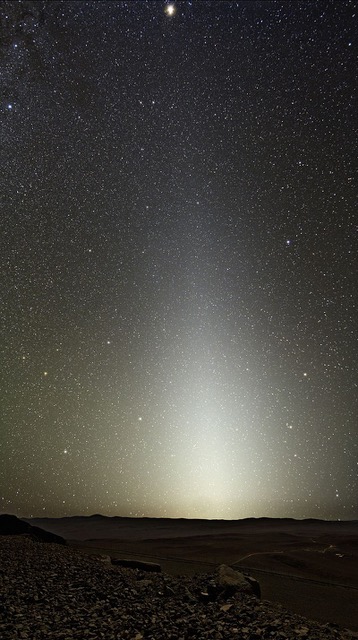Sky Report: February 28 – March 6

Caption: The zodiacal light as seen from a mountaintop observatory in Chile. Credit: ESO/Y.Beletsky
Once again the moon is near the planet Uranus. On the evening of the 6th the distant planet is 2½° (5 moon-diameters) straight above the crescent moon and you can see both together in binoculars.
The other planets are in the morning sky. Venus is brilliant, low in the southeast before sunrise, far brighter than anything in the sky except the sun and moon.
Almost 5° below Venus, at the 5 o’clock position, is Mars. Mars is only 1/100th as bright, and that’s because it’s on the far side of the sun almost 200 million miles from earth. It’ll be a fraction that distance and brighter than the brightest stars when we it is closest to earth in December.
Saturn and Mercury are separated by a scant 2/3° and would be visible together in a low-power telescope if they weren’t so near the horizon that it will be nearly impossible to see them.
Jupiter is behind the sun on the 5th when it technically moves into the morning sky.
If you have a truly dark sky where you can see the Milky Way, look for something unusual that very few people have ever seen — the zodiacal light. It’s at its best the next few weeks. The zodiacal light is a faint diffuse triangular glow rising up from the western horizon that rivals the Milky Way in brightness. It’s about 25° wide at its base and narrow up high where it fades away. The glow is sunlight scattered forward by countless microscopic particles of interplanetary dust, typically the size of smoke particles to fine dust, that orbit the sun in the plane of the solar system. This time of year it’s visible in the evening; in autumn it’s visible in the morning; both are when the ecliptic (the path of the planets) makes a steep angle with the horizon and the zodiacal light sticks relatively straight up. Most of these particles are dust shed by comets while some come from collisions of asteroids, and one study published just last March suggests that some come from Mars, although it’s not known how they would get from Mars, or one of its moons, into the into interplanetary space. If you can see the Milky Way you should see the zodiacal light. Avoid moonlit nights.
Queen guitarist Brian May’s PhD thesis in astrophysics was on motions in the zodiacal light.
Thanks to a 2021 grant from the Utah Governor’s Office of Economic Opportunity and the Kane County Office of Tourism, Stellar Vista Observatory offers portable telescopes and tripod mounted binocular kits on loan for free to all residents of Kane County. Nothing beats a quality binocular or astronomical telescope to enhance enjoyment of the night sky!
Visit https://stellarvistaobservatory.org/discover-the-night-sky/ or Kanab City Library for full details.
The Sky Report is presented as a public service by the Stellar Vista Observatory, a nonprofit organization based in Kanab, Utah, which provides opportunities for people to observe, appreciate, and comprehend our starry night sky. Additional information is at www.stellarvistaobservatory.org. Send questions and comments to John@StargazingAdventures.org.






Comments are closed.